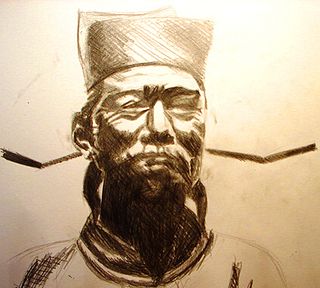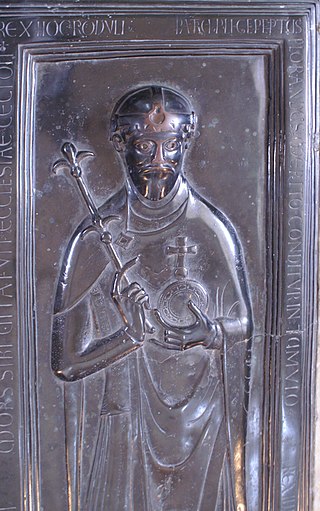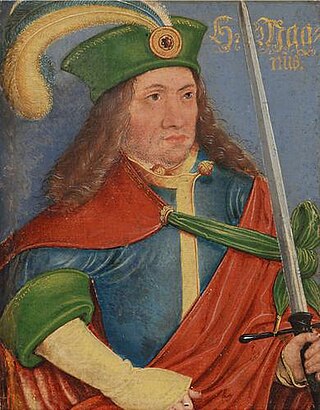
Year 1075 (MLXXV) was a common year starting on Thursday of the Julian calendar.

Anno II was Archbishop of Cologne from 1056 until his death. From 1063 to 1065 he acted as regent of the Holy Roman Empire for the minor Emperor Henry IV. Anno is venerated as a saint of the Catholic Church.

Adalbert was Archbishop of Bremen from 1043 until his death. Called Vikar des Nordens, he was an important political figure of the Holy Roman Empire, papal legate, and one of the regents for Emperor Henry IV.
The First Battle of Langensalza was fought on 9 June 1075 between forces of King Henry IV of Germany and several rebellious Saxon noblemen on the River Unstrut near Langensalza in Thuringia. The battle was a complete success for Henry, resulting in the subjugation of the Saxons shortly before the Investiture Controversy commenced. In Germany the battle is known as the Schlacht bei Homburg an der Unstrut, after a nearby Kaiserpfalz and monastery.

Rudolf of Rheinfelden was Duke of Swabia from 1057 to 1079. Initially a follower of his brother-in-law, the Salian emperor Henry IV, his election as German anti-king in 1077 marked the outbreak of the Great Saxon Revolt and the first phase of open conflict in the Investiture Controversy between Emperor and Papacy. After a series of armed conflicts, Rudolf succumbed to his injuries after his forces defeated Henry's in the Battle on the Elster.
Lambert of Hersfeld was a medieval chronicler. His work represents a major source for the history of the German kingdom of Henry IV and the incipient Investiture Controversy in the eleventh century.

Magnus was the duke of Saxony from 1072 to 1106. Eldest son and successor of Ordulf and Wulfhild of Norway, he was the last member of the House of Billung.
Otto of Nordheim was Duke of Bavaria from 1061 until 1070. He was one of the leaders of the Saxon revolt of 1073–1075 and the Saxon revolt of 1077–1088 against King Henry IV of Germany.
Bruno the Saxon, also known as Bruno of Merseburg or Bruno of Magdeburg, was a German chronicler of the eleventh century and author of the Historia de Bello Saxonico.

The Diocese of Halberstadt was a Roman Catholic diocese from 804 until 1648. From 1180, the bishops or administrators of Halberstadt ruled a state within the Holy Roman Empire, the prince-bishopric of Halberstadt. The diocesan seat and secular capital was Halberstadt in present-day Saxony-Anhalt.
Egbert II was Count of Brunswick and Margrave of Meissen. He was the eldest son of the Margrave Egbert I of the Brunonen family.
Siegfried I was the Abbot of Fulda from 25 December 1058 until 6 January 1060, and from January 1060 until his death in February 1084, he was Archbishop of Mainz.
Burchard of Veltheim was a German cleric and Bishop of Halberstadt from 1059 until his death.
Liemar was archbishop of Hamburg-Bremen from 1072 to 1101, and an important figure of the early Investiture Contest.

Benno II was Bishop of Osnabrück from 1068 until his death. He served as a close advisor and architect of Emperor Henry IV. In 1080 he founded the Benedictine abbey of Iburg Castle.
Battle of Mellrichstadt was fought between Holy Roman Emperor Henry IV and the German anti-king Rudolf of Swabia on 7 August 1078 near Mellrichstadt.

Henry IV was Holy Roman Emperor from 1084 to 1105, King of Germany from 1054 to 1105, King of Italy and Burgundy from 1056 to 1105, and Duke of Bavaria from 1052 to 1054. He was the son of Henry III, Holy Roman Emperor—the second monarch of the Salian dynasty—and Agnes of Poitou. After his father's death on 5 October 1056, Henry was placed under his mother's guardianship. She made grants to German aristocrats to secure their support. Unlike her late husband, she could not control the election of the popes, thus the idea of the "liberty of the Church" strengthened during her rule. Taking advantage of her weakness, Archbishop Anno II of Cologne kidnapped Henry in April 1062. He administered Germany until Henry came of age in 1065.

The Saxon revolt refers to the struggle between the Salian dynasty ruling the Holy Roman Empire and the rebel Saxons during the reign of Henry IV. The conflict reached its climax in the period from summer 1073 until the end of 1075, in a rebellion that involved several clashes of arms.
Tedald was archbishop of Milan from 1075 to 1085.
Herrand was a German prelate who served as abbot of Ilsenburg and bishop of Halberstadt (1090–1102).